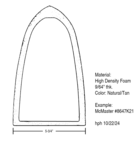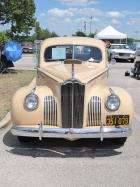|
Re: WCFB Carburetor Venturi inserts?
|
||||
|---|---|---|---|---|
|
Just can't stay away
|
I was curious as to why y'all kept referring to the Carter-2084-S, so I looked in my Packard carburetor list (came from here), and sure enough, it lists both carbs for that year.
After realizing this, I did a search on here and found this thread. Here is a quote from BH in that thread: Quote:
Pretty interesting stuff. Hopefully this clears up some info for someone in the future. -Chris
Posted on: 2021/3/2 23:44
|
|||
|
||||
|
Re: WCFB Carburetor Venturi inserts?
|
||||
|---|---|---|---|---|
|
Home away from home
|
Chris R
The main difference between the 985S and 2084S configurations is the diameter of the secondary ‘main venturi’. The 985S parts list uses a 1 1/16 venturi, while the 2084S uses a 15/16 item. As you would expect once you change a venturi there were also different ‘jetting’ between the two carburetors. The original venturi size is cast into the float bowl/venturi casting, and can be seen in the photo as 1 1/16. Carter manuals acknowledge the interchangeability between the 985S and 2084S carburetors The plot thickens somewhat in the ’54 Cavalier. In that application there is a 15/16 ‘secondary main venturi’ model (2103S), and a 1 1/16 ‘secondary main venturi’ model (2124S). My ’54 Cavalier is equipped with a 2103S carburetor . . . . which would be the smaller of the two. Seems that WCFB carburetors with a 15/16 secondary venturi is rarer than I would have guessed. Oldsmobile used them in ’53, ’54, and ’55. For each of the original carburetors there was a later model replacement, but those replacements were also configured with a 15/16 secondary venturi. I could not find another example where the replacement carburetor had a smaller secondary venturi. The float bowl/venturi casting (known as the Main Body in Carter speak) is one of the few parts (perhaps the only) that does not appear in the illustrated parts list. Back in the day you can buy the body flange assembly and the air horn assembly, but not the casting between the two, leaving us with the possibility that the Packard dealer may not have been able to buy the parts necessary to convert a 985S to a 2084S at the dealer. I guess this assumes there was an itchy that needed scratching out in the field and whether the ’53 Cavalier was misbehaving. Given that other car manufacture’s where not ‘down-sizing’ the secondary’s I’m thinking Packard was not chasing lower fuel volatility. Now the question is whether the casting in the photo was modified by an individual, or was it an authorized repair/overhaul procedure to convert the larger casting to the smaller specifications. I would think the step between the Main Body and the venturi inserts suggest this was not a Carter modification. I would question whether that geometry would ever act as a venturi . . . lots of turbulence shedding off of the edge, and those areas where material was removed (aligned with the struts holding the primary venturi) look like another opportunity to create turbulence. I’ve never seen anything like your photo, or heard of venturi chokes, and I was an old hotrodder . . . just old now! I can’t imagine how much CFM that modification cost. What secondary jets and metering rods are installed? dp
Posted on: 2021/3/3 23:27
|
|||
|
||||
|
Re: WCFB Carburetor Venturi inserts?
|
||||
|---|---|---|---|---|
|
Home away from home
|
Measure the diam with the inserts and see if it's 15/16".
Since it's cast symmetric, they had to use inserts/sleeve to reduce the bore. From the hammer marks, it's was most likely hand formed, not pressed, but I wouldn't rule it as "homemade". I don't know this model, but if called for in the specs, it probably matches the advance curve, etc to provide the correct fuel flow. This is carburetor's "magic era". Didn't get them figured out til about the late 60s. It may not perform well with larger stock secondaries, if the cam isn't designed for that. ie, a smooth riding family car vs max HP. Unless you want to get into a complete performance redo, I'd leave them, if it was working OK before. I suspect if you take them out you might have to re-jet, etc. to correct the fuel mix. Not a biggie, per se. The change in flow is minor. Could even be some "economy" gadget they hawked back in the day. Lots of things happen over that many years.
Posted on: 2021/3/6 14:34
|
|||
|
||||
|
Re: WCFB Carburetor Venturi inserts?
|
||||
|---|---|---|---|---|
|
Just can't stay away
|
Quote:
Yikes! I supper apologize for the late reply! I saw your reply earlier but totally spaced on getting back to you. Sorry again about that! Anywho, that's super interesting info about the different variations of this carburetor. I would have never thought prior to rebuilding this carb that there were more than one. My carb definitely has 1 1/16 casted on both sides. As far as jetting goes, I want to say that all of the top (low speed) jets were the same. The lower jets next to the needles were larger than the ones in the rear. Unfortunately, the carb is all put back together so I can't say for certain what any of 'em are at this point. Haha! You're only as old as ya feel man! Yeah, I've never heard of 'em either. I left 'em in for the time being though. I figure, it must have been running before, so we'll see what happens. Thanks again for the help! I super appreciate it!
Posted on: 2021/3/22 20:45
|
|||
|
||||
|
Re: WCFB Carburetor Venturi inserts?
|
||||
|---|---|---|---|---|
|
Just can't stay away
|
Quote:
Hey Jim! I apologize to you as well! I totally spaced on getting back to everyone. Unfortuanly I got the carb together right after my last reply. I don't think I'd be able to accurately measure them as of right now. Yeah, I agree that they look hand formed. I don't know if I mentioned it before or not, but the receipts found in the glovebox show that the carb has been rebuilt at least three or four times since the mid seventies. Maybe one of those shops performed the modification. I did leave 'em in there. I figured it couldn't hurt because the car probably ran before in it's current configuration. Although, whoever rebuilt it last, or got into it last, did a HORRIBLE job at rebuilding it. Every single setting was out of spec (some by a lot). The piston in the starter switch housing was upside down, the thermostat plate (choke baffle) was missing, along with a few linkage washers. Also, a bunch of screws were swapped around and in the wrong places. So, who knows how well she actually ran before. I guess we'll find out soon enough. Anywho, thanks for the info and sorry again. -Chris
Posted on: 2021/3/22 21:00
|
|||
|
||||







